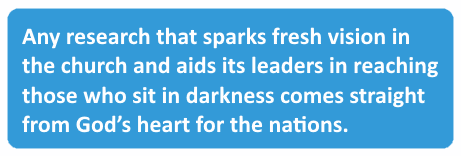Insights from a Veteran Mission Information Worker
A guest post by Jeanie Curryer, formerly Director of OC Research
I am writing this one week before I retire after 45 years of involvement in missions, over 30 of which were focused primarily on research. Before becoming a researcher, I was an English teacher at Faith Academy outside of Manila, not the most likely background for an information worker. Nevertheless, in 1985 at the prompting of the president of my mission, I was assigned to a new ministry in research. After a few weeks of training in church growth research at our headquarters, I returned to Manila and found myself suddenly involved in a survey focused on locating every church in Metro Manila, which at that time was comprised of four cities and 13 municipalities with a total population over eight million.
 The Disciple A Whole Nation (DAWN) saturation church planting movement was underway, and many denominations were heavily engaged in starting new churches in support of the goal of seeing a church in every barangay (village or neighborhood) or a total of 50,000 churches in the Philippines by the year 2000. My agency was fully involved in supporting this movement, but two pressing questions nagged at us. How can the Philippine Church monitor the progress they’re making toward this goal if we don’t know which barangays do and don't have churches? And, how do we go about answering this question? The 1985 Metro Manila Church Survey was our first attempt to address this dilemma.
The Disciple A Whole Nation (DAWN) saturation church planting movement was underway, and many denominations were heavily engaged in starting new churches in support of the goal of seeing a church in every barangay (village or neighborhood) or a total of 50,000 churches in the Philippines by the year 2000. My agency was fully involved in supporting this movement, but two pressing questions nagged at us. How can the Philippine Church monitor the progress they’re making toward this goal if we don’t know which barangays do and don't have churches? And, how do we go about answering this question? The 1985 Metro Manila Church Survey was our first attempt to address this dilemma.
We had never done this kind of research before and didn’t really know what we were doing. We determined that the only way to get this information was to take a list of known churches and drive through every section of Metro Manila, updating our list and noting church locations on city maps. It took us 18 months to complete. At the end we were able to develop a packet of information, a list of churches and maps with church locations and church-to-population ratios for each city and municipality in Metro Manila to assist pastors and church planters in deciding where to direct their efforts.
Besides getting a crash course in doing church location studies, I learned two primary principles in doing this kind of research. The first was to test commonly held assumptions, especially when they lead to decisions as to how to use kingdom personnel and resources. In this case, most denominational and church leaders in Metro Manila thought that the city didn’t really need more churches and so were assigning new church planters to the provincial areas. Instead, results from the survey showed that Metro Manila was one of the least-churched regions in the country.
The second insight came one afternoon as I was studying a map of Metro Manila that depicted church-to-population ratios for all the barangays. The darker parts of the map indicated the least-churched sections, the lighter shaded areas the most-churched. I sensed the Lord urgently saying to me, “Jeanie, do you see what I see?” I looked more closely at the darkest areas clustered around Manila Bay. I knew that these barangays were made up of neighborhoods densely populated by the urban poor. Then I noticed that many of the lighter parts of the map were south and east of the city where new subdivisions were being built to accommodate the influx of the growing middle class.
Suddenly, I realized what the Lord was saying to me. Most of the new church plants were focused on the middle-class migration to the suburbs while the urban poor were being neglected, the very neighborhoods that most desperately needed more churches. This realization led to the second principle I learned. Often the results of our research will yield prophetic messages that urgently need to be passed on to denominational and other church leaders. Consequently, our responsibility as researchers is not only to do the research and analysis, but to then pray and wait on the Lord to discern what insights He most wants passed on to the church.
In doing this initial study we learned the basics of carrying out church location research. In the next few years we surveyed other major cities and gradually learned how to track the Philippine church’s progress toward the DAWN goal. In 1989 we were finally ready to survey the whole country, and three years later it was completed. We were able for the first time to give Philippine church leaders a clear picture of where the Protestant churches were located and which parts of the country were the most unchurched.
Not surprisingly we learned that doing research on a national scale takes careful planning and requires dealing with numerous logistical issues. What did surprise me, though it shouldn’t have, was the intense spiritual warfare that increased as we approached completion of the survey. Doing this kind of research, especially on a large scale, turns the searchlight on dark, unchurched areas and provides clear vision for church leaders in directing their efforts. Satan, of course, doesn’t like this and fights back. Through this we learned how vital it is to cover all aspects of our research with strong intercessory prayer.
In working on these two church location surveys over a period of six years, one overarching lesson stands out. Any research that sparks fresh vision in the church and aids its leaders in reaching those who sit in darkness comes straight from God’s heart for the nations. In the years following, it was this one primary insight that fueled in me a passion to encourage others to engage in missions research. What a privilege it has been to serve as their champion for the past 30 years.
This article first appeared in the bulletin of the Community of Mission Information Workers, Volume 8, Number 3, July 2018. Used with permission. To learn more about he Community of Mission Information Workers, visit GlobalCMIW.org
- Log in to post comments
